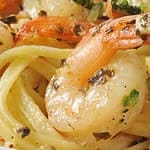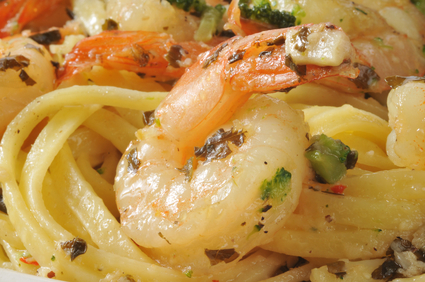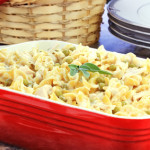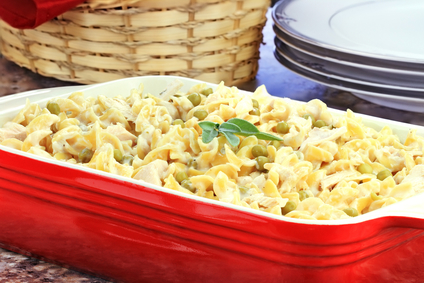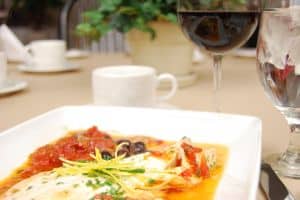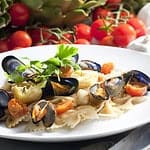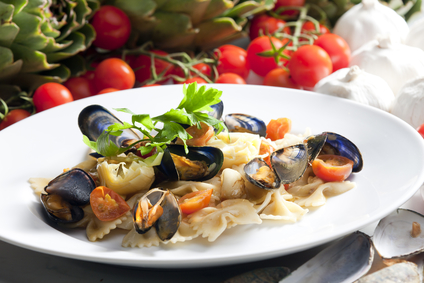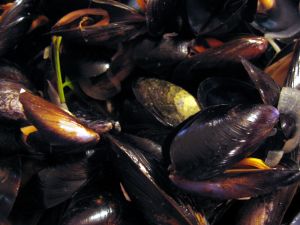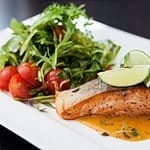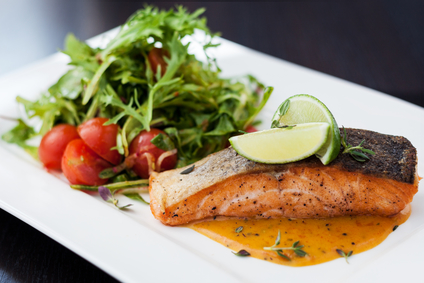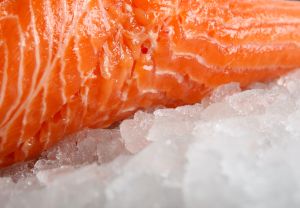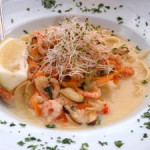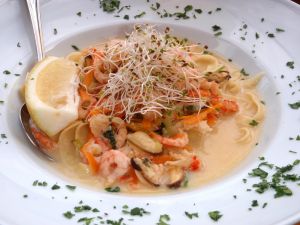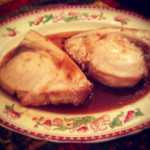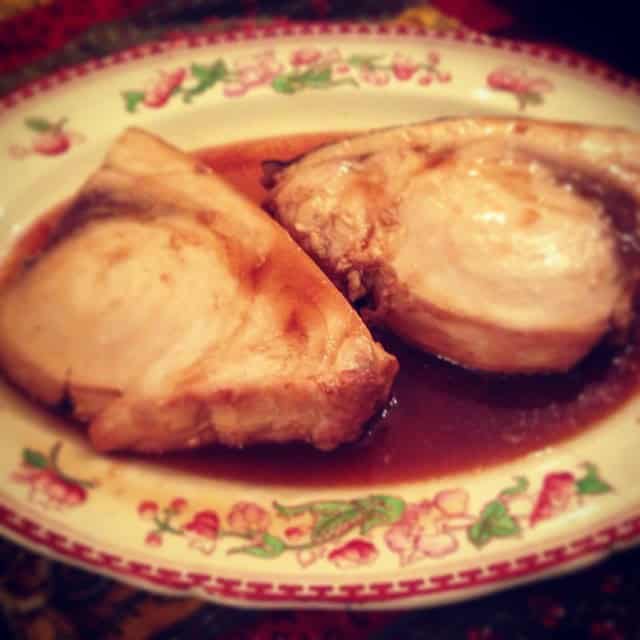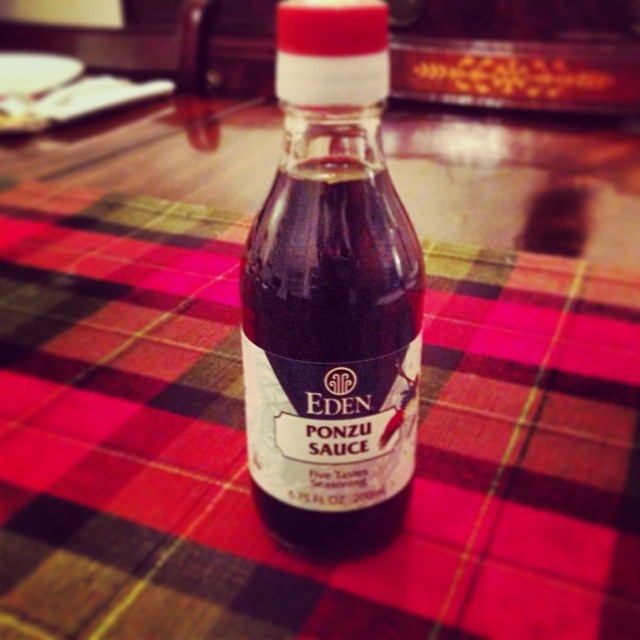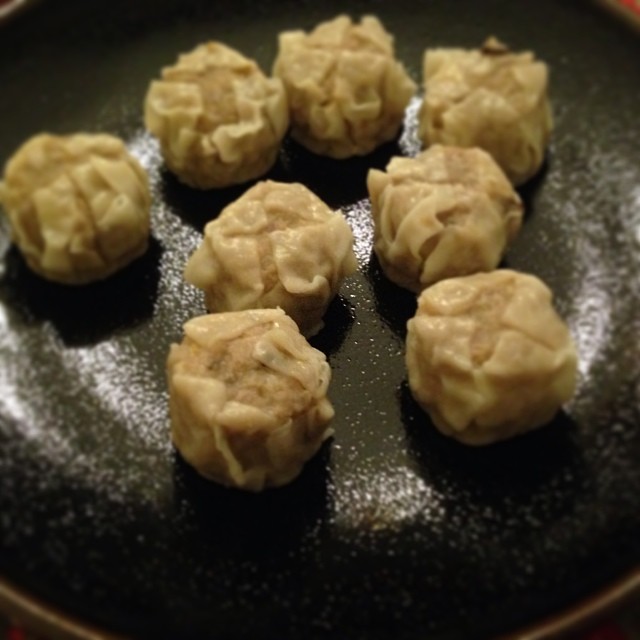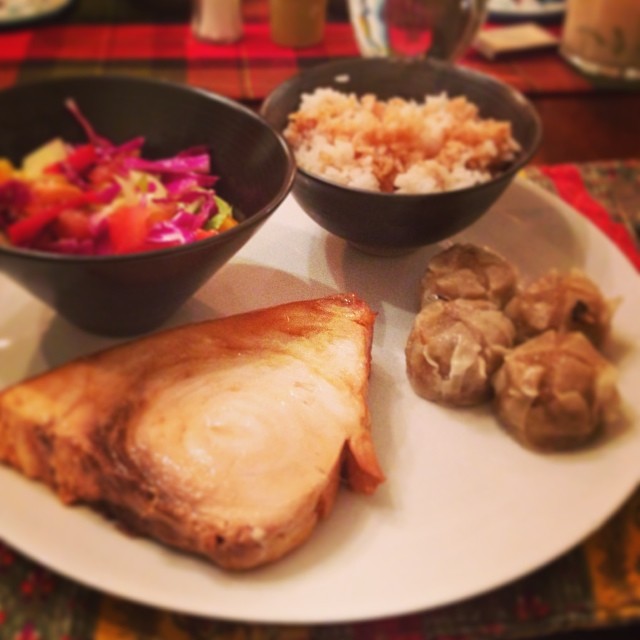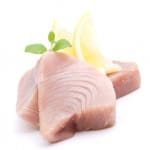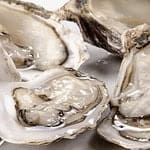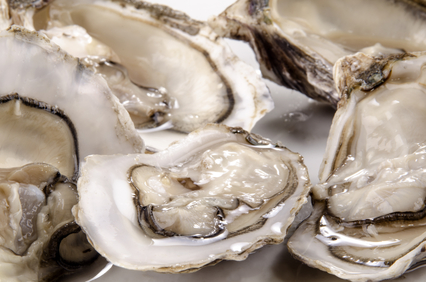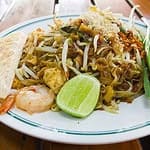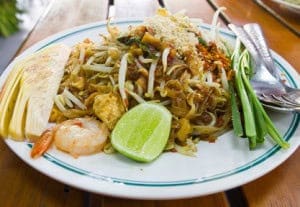Garlic & Herb Shrimp Sauté
Here is a super easy weeknight meal. You can serve over cooked pasta if you like. My Garlic & Herb Shrimp is absolutely delicious! Spur-of-the-moment hosting is no hassle with this simple, but delightfully sumptuous entrée.
INGREDIENTS
1 1/2 Pounds Fresh or Frozen Large Shrimp In Shells
1 Medium Thinly Sliced Leeks or 3 Thinly Sliced Green Onions
1/2 Teaspoon Crushed Dried Basil
5 Minced Garlic Cloves
3 Tablespoons Olive Oil
2 Tablespoons Dry White Wine
1 Tablespoon Lemon Juice
1/2 Teaspoon Kosher Salt
1/2 Teaspoon Freshly Ground Pepper
1 Tablespoons Snipped Fresh Parsley
If your shrimp is frozen make sure to thaw it in the fridge. Do NOT thaw on the counter. Peel and devein shrimp, leaving tails intact. Rinse shrimp. Pat dry with paper towels and set aside. In a large-size sauté add olive oil and turn heat to medium-high. Add shrimp, leeks (or green onions), basil, and garlic. Cook for about 4 minutes until shrimp are opaque. Slowly add white wine, lemon juice, kosher salt, and pepper. Cook and stir for 2 minutes JUST until heated through. Stir in parsley and cook for another 30 seconds. Remove from heat and serve alone or over cooked pasta. Serves 4
Mussels With Wine, Tomatoes & Herbs
Experts fear that marine mercury levels could double by the middle of this century. Since consuming large amounts of mercury can be unhealthy for us, we should avoid eating a lot of the large predatory swimmers that tend to be the highest in mercury, such as swordfish, tuna, king mackerel, and shark.
INGREDIENTS
1/2 Teaspoon Olive Oil
4 Tablespoons Minced Shallots
3 Teaspoons Minced Garlic
1 Chopped Portobello Mushroom
2 Cups Halved Cherry Tomatoes
12 Black Mussels (Scrubbed & Debearded)
1 Teaspoon Minced Fresh Oregano
1 Teaspoon Minced Fresh Parsley
1 Teaspoon Minced Fresh Thyme
2 Cups Dry White Wine
1/2 Teaspoon Kosher Salt
1/2 Teaspoon Freshly Ground Pepper
2 Teaspoons Unsalted Butter
In a large-size sauté pan heat olive oil over a high heat. Add shallots and garlic and cook for 2 minutes. Stir frequently. Add mushrooms and cook for 2 more minutes. Add tomatoes and cook for 15 seconds. Add mussels and shake pan well. Cook for 30 seconds to 1 minute until mussels start to open up. Stir in oregano, parsley, and thyme. Pour in the wine and bring to a boil. Add butter, stir to incorporate. Reduce heat to medium and cook, uncovered, for 3 to 4 minutes until mussels completely open and liquid is reduced. Remove pan from heat. Season with kosher salt and pepper. Stir well. Transfer to serving bowls or over cooked pasta. Serves 2 to 4
Asian Salmon
The omega-3 fats in this lean protein increase the productions of a compound that repairs damaged cells and helps control inflammation. Besides salmon is absolutely delicious. Serve with a salad and oven roasted winter vegetables such as butternut squash and sweet potatoes.
INGREDIENTS
2 Tablespoons Olive Oil
Zest of 1 Lime
2 Tablespoons Coriander
1 Teaspoon Minces Fresh Ginger
4 Pieces Salmon (4 Ounces Each)
2 Tablespoons Honey
1/2 Teaspoon Freshly Ground Pepper
2 Tablespoons Soy Sauce
Preheat your oven to 325 degrees. In a small-size bowl combine oil, lime zest, coriander, and ginger. Place salmon in a medium-size ovenproof baking dish and brush with oil mixture. Place in oven and bake for 15 to 20 minutes, then turn on broiler and crisp for 3 more minutes. Transfer to serving plate. To serve, mix honey and pepper. Drizzle over fish with soy sauce. Serves 4
Note: You may use light soy sauce or gluten free soy sauce.
Tagliatelle With Seafood
Growing up my family never ate meat on Christmas Eve. We always had oyster stew, which, I have to admit; I didn’t appreciate until I got older. My husband is Italian and we are both Catholic so we continue the no meat Christmas Eve tradition before heading off to midnight mass. As you may remember I just returned from my culinary travels to Europe where I was able to make pasta with an amazing Roman chef. I thought that this year I might make Tagliatelle With Seafood for our Christmas Eve dinner. It’s really wonderful and is a somewhat lighter dish then what you’ll probably be eating on Christmas Day. This could also be one of your “Feast of the Seven Dishes” dishes if you are of Italian decent.
INGREDIENTS
12 Ounces Mussels In The Shell
12 Ounces Clams
12 Ounces Cleaned Squid
12 Ounces Cuttlefish
12 Ounces Shrimp Tails
1/2 Cup Olive Oil
4 Cloves Finely Chopped Garlic
3 Tablespoons Finely Chopped Fresh Parsley
1/2 Cup Dry White Wine
1/2 Teaspoon Kosher Salt
1/2 Teaspoon Freshly Ground Pepper
1 Pound Tagliatelle
Soak the mussels and clams in a large bowl of cold water for 1 hour changing the water often. Chop the squid and cuttlefish bodies into rounds and the tentacles into short pieces. Do not peel the shrimp tails. Pour 3 tablespoons of the olive oil into a large sauté pan. Add the mussels and clams and cook over a medium heat for 8 to 10 minutes until they have all opened up. Heat the remaining oil in a large sauté pan over a medium heat. Add the garlic and parsley and sauté for 3 minutes until the garlic is pale gold. Add the squid and cuttlefish. Add kosher salt and pepper. Cook for 1 minute and then add the wine. Simmer over a low heat for 45 minutes until squid and cuttlefish are tender. Add shrimp tails, clams, and mussels and simmer over medium heat for 5 minutes until seafood is cooked. If you prefer take out the mussels and clams from their shells, leaving just a few in the shell to make the finished dish look more attractive. Meanwhile, cook the tagliatelle in a large pot of salted boiling water until al dente. Drain and add to the pan with the seafood sauce. Toss well and transfer to a serving bowl. Serve hot. Serves 4
Fish in Ponzu Sauce
I typically don’t eat much fish because the oceans are over-fished. Once in awhile I will drop by my upscale local fishmonger and pick up a pound of fish. When I get home I always wonder how to cook it and usually I just end up searing it. For the past few years I’ve been trolling the Asian grocery stores and came across Ponzu Sauce, which is a citrus-based sauce, used in Japanese cooking. Regular grocery stores are beginning to carry Ponzu Sauce, but if you can’t find it then go to your local Asian food store or check on Amazon. Here is an absolutely delicious and ridiculously easy way to cook fish. I made mine with line-caught swordfish (which cost me a fortune!), but you can use any fish for this recipe. If you have questions about which fish you should or shouldn’t purchase go to this link: http://www.montereybayaquarium.org/cr/seafoodwatch.aspx.
INGREDIENTS
1 to 2 Cups Ponzu Sauce
1 Pound Skinless & Boneless Fish (Your Choice)
Preheat your oven to 350 degrees. In an ovenproof baking pan pour 1/2 cup Ponzu Sauce. Wash & pat dry fish. Place fish in dish. Pour rest of the sauce over fish. Place, uncovered, in oven and bake for 20 to 30 minutes depending on how thick your fish is. Remove from oven and transfer to serving platter. Spoon excess sauce over fish. Serve immediately. I served my fish with sticky rice, pork dumplings and salad. Serves 2
Seared Tuna With White Beans & Artichokes
Fresh tuna is an important source of omega-3 fats and antioxidant minerals for arterial and heart health, and is also rich in vitamin E for healthy skin. Research has found that when tuna is canned (whether in oil, water, brine, or a sauce) it loses most of its beneficial omega-3 fats, so shouldn’t count toward your oily fish intake.
The firm dense, and meaty, flavorful flesh of fresh or frozen tuna is an ideal choice of fish for nonfish lovers and is quick to cook. It is an excellent source of protein and is especially rich in B vitamins, selenium, and magnesium. A small portion will contain around 20 percent of your daily vitamin E needs. While most types of tuna contain fewer of the essential omega-3 fats than some other oily fishes do, there is still a good content of EPA and DHA fats. DHA is particularly effective in keeping our hearts and brains healthy and in good working order. Just one portion of tuna a week can provide the recommended 1.4 g of these fats a week.
Fresh fish should be odorless and is best cooked and eaten on the day of purchase. To retain all the health benefits of the omega-3 fats, lightly sear tuna in a pan on both sides and cook for as little time as you can. Tuna steaks can also be sliced and stir-fried for one minute with sliced vegetables- unlike many types of fish, the slices won’t disintegrate.
INGREDIENTS
1/3 Cup Olive Oil
Juice of 1 Lemon
1/2 Teaspoon Red Chili Flakes
1/4 Teaspoon Freshly Ground Pepper
4 Thin Fresh Tuna Steaks (About 1 Pound)
12 Ounces Canned Cannellini Beans (Drained & Rinsed)
1 Finely Chopped Shallot
1 Crushed Garlic Clove
2 Teaspoons Finely Chopped Fresh Rosemary
2 Teaspoons Finely Chopped Fresh Flat Leaf Parsley
4 Drained & Quartered Artichokes (In Oil)
2 Sliced Lengthwise Into Segments Ripe Tomatoes
16 Pitted Black Olives
1 Teaspoon Kosher Salt
1 Teaspoon Freshly Ground Pepper
1 Lemon Sliced Into Wedges To Serve
Place 4 tablespoons of the olive oil in a shallow dish with 3 tablespoons of the lemon juice, the chili flakes, and 1/4 teaspoon pepper. Add the tuna steaks and let marinate at room temperature for 1 hour. Turn occasionally. Tip the cannellini beans into a microwavable bowl and heat on medium for 2 minutes. While still warm, toss with 4 tablespoons of the oil, then stir in the shallots, garlic, herbs, and remaining lemon juice. Season with the kosher salt and pepper. Let stand for at least 30 minutes to allow all of the flavors to develop. Brush a grill pan or nonstick skillet with a little of the remaining oil and heat until very hot. Shake off any surplus marinade from the tuna, add to the pan, and sear for 1 to 2 minutes each side over very high heat. Remove the tuna steaks to a cutting board or plat. Reduce the heat to low and add the marinade to the pan to cook for 1 to 2 minutes. Add the beans into a serving dish. Mix in the artichokes, tomatoes, and olives and any marinade juices from the skillet. Transfer to a serving platter. Flake the tuna and arrange on top. Garnish with lemon wedges and serve at room temperature. Serves 6
Fried Oysters With Dill Tartar Sauce
The trick to cooking great oysters is to buy them at their best and avoid overcooking. Buy oysters with tightly closed and unbroken shells. Refrigerate live oysters covered with a moist cloth in an open container for 1 to 2 days.
INGREDIENTS
1 Quart Oysters
1 Teaspoon Onion Powder
2 Tablespoons Milk
2 Eggs
1 Cup Fine Cracker Crumbs
3 Tablespoons Chopped Fresh Parsley
1/2 Teaspoon Kosher Salt
1/2 Teaspoon Freshly Ground Pepper
Vegetable Oil For Frying
Lemon Wedges
Drain oysters. Combine eggs, milk, and onion powder in a medium-size bowl. In a separate medium-size bowl combine cracker crumbs and parsley. Dip the oysters in the egg mixture, then the cracker crumbs. Heat the oil to 375° in a large-size sauté pan. Fry the oysters until golden brown. Serve with lemon wedges and tartar sauce. Serves 4
Dill Tartar Sauce
INGREDIENTS
1 Cup Mayonnaise
1/4 Cup Snipped Fresh Dill
2 Tablespoons Fresh Lemon Juice
2 Tablespoons Pickle Relish
2 Tablespoons Capers
Combine all of the ingredients in a small-size bowl and place into fridge for at least 1 hour before serving. Serve with oysters or other seafood.
Authentic Pad Thai is made with rice noodles that are available at Asian markets. Use the 1/8th inch rice noodles if you can find them. If you can’t find rice noodles then use angel hair pasta or linguine and cook according to the package instructions.
INGREDIENTS
8 Ounces Rice Stick Noodles
1/4 Cup Fresh Lime Juice
1/2 Cup Asian Fish Sauce
2 Tablespoons Sugar
1 Tablespoon Vegetable Oil
8 Ounces Shelled and Deveined Shrimp
3 Chopped Garlic Cloves
1/4 Teaspoon Crushed Red Pepper
3 Lightly Beaten Large Eggs
2 Cups Bean Sprouts
1/3 Cup Coarsely Chopped Unsalted Roasted Peanuts
4 Thinly Sliced Green Onions
1/2 Cup Chopped Fresh Cilantro Leaves
Lime Wedges
In a large-size bowl, soak the rice stick noodles in enough hot water to cover the noodles for 20 minutes. Drain the noodles and with kitchen scissors, cut the noodles into 4 inch lengths. If you are using angel hair or linguine pasta then break in half. Cook in a large-size saucepot as the label instructs. Drain and rinse with cold water. Shell and devein the shrimp and then cut the shrimp lengthwise in half. In a small-size bowl combine the lime juice, fish sauce, and sugar. Assemble all of your other ingredients and place them next to the stove as the cooking procedure will be rather quick. In a large-size skillet or wok add the vegetable oil and turn the heat to high until the oil is hot. Add the shrimp, garlic, and crushed red pepper. Cook while stirring for 1 minute. Add the lightly beaten eggs and cook, stirring for about 20 seconds until they are just set. Add the drained noodles and cook for 2 minutes. You will want to continue stirring while cooking. Add the fish sauce mixture, half of the bean sprouts, half of the peanuts and half of the green onions. Cook for 1 minute. Remove from the heat and transfer the Pad Thai to a warm platter or serving bowl. Top with the remaining bean sprouts and sprinkle with the remaining peanuts, remaining green onions, and cilantro. Serve with lime wedges. Makes 4 servings.

